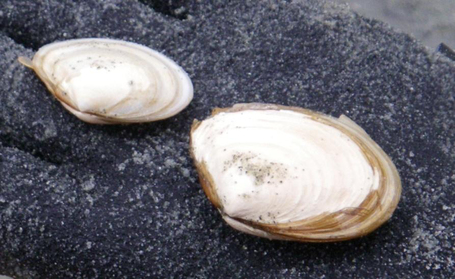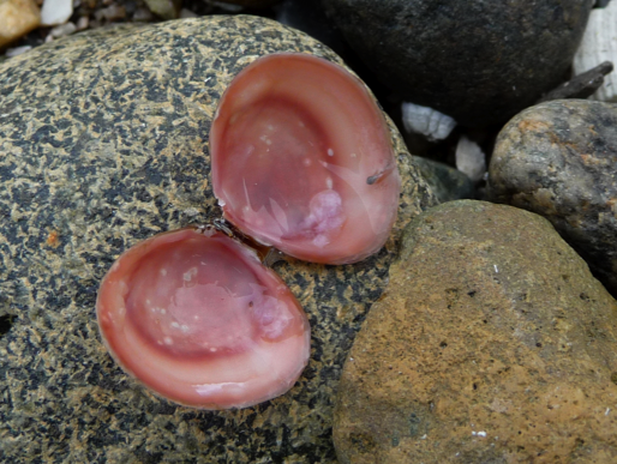Baltic macoma, tiny pink clam, inconspicuous macoma • Macoma balthica
|
Baltic macoma shells are often brightly coloured. White-shelled individuals may be confused for a pointed macoma (M. inquinata): the two are compared in the top left photo, with the baltic macoma at left and the pointed at right. Photos by Chanda Brietzke and Jessica Brown.
|
Identification
This small clam species grows to 4 cm long and has oval-shaped shell valves. Despite the name 'tiny pink clam,' it can be a variety of colours - from pink or blue to yellow or orange.
Habitat & Range
The Baltic macoma lives buried to 20 cm below the surface in sandy or muddy bays and estuaries, from the intertidal to a depth of 40 m. In the Pacific Northwest it occurs from northern Alaska to southern California; it is currently listed as a circumboreal species, though Atlantic populations may actually represent a separate species.
Similar Species
White-shelled baltic macomas may be confused with the pointed macoma (Macoma inquinata), which is a bit larger and can be distinguished by a relatively large external hinge ligament as well as its wedge-shaped (rather than oval) shell valves.
Human Uses
The colourful Baltic macoma shells are often prized by beachcombers.
Intriguing Info
Birds that prey on this species ingest it whole.
This small clam species grows to 4 cm long and has oval-shaped shell valves. Despite the name 'tiny pink clam,' it can be a variety of colours - from pink or blue to yellow or orange.
Habitat & Range
The Baltic macoma lives buried to 20 cm below the surface in sandy or muddy bays and estuaries, from the intertidal to a depth of 40 m. In the Pacific Northwest it occurs from northern Alaska to southern California; it is currently listed as a circumboreal species, though Atlantic populations may actually represent a separate species.
Similar Species
White-shelled baltic macomas may be confused with the pointed macoma (Macoma inquinata), which is a bit larger and can be distinguished by a relatively large external hinge ligament as well as its wedge-shaped (rather than oval) shell valves.
Human Uses
The colourful Baltic macoma shells are often prized by beachcombers.
Intriguing Info
Birds that prey on this species ingest it whole.
References
Adams, M.J. (2006). Macoma balthica (Baltic Macoma). Beach Watchers. Washington State University. Accessed 02/09/2014.
Harbo, R. M. (1999). Whelks to whales: Coastal marine life of the Pacific Northwest. Madeira Park, BC: Harbour Publishing. P. 95.
Lamb, A., and Hanby, B. (2005). Marine Life of the Pacific Northwest [electronic resource]. Madeira Park, BC: Harbour Publishing.
Authors and editors of page
Kelly Fretwell and Brian Starzomski (2014).
Adams, M.J. (2006). Macoma balthica (Baltic Macoma). Beach Watchers. Washington State University. Accessed 02/09/2014.
Harbo, R. M. (1999). Whelks to whales: Coastal marine life of the Pacific Northwest. Madeira Park, BC: Harbour Publishing. P. 95.
Lamb, A., and Hanby, B. (2005). Marine Life of the Pacific Northwest [electronic resource]. Madeira Park, BC: Harbour Publishing.
Authors and editors of page
Kelly Fretwell and Brian Starzomski (2014).






